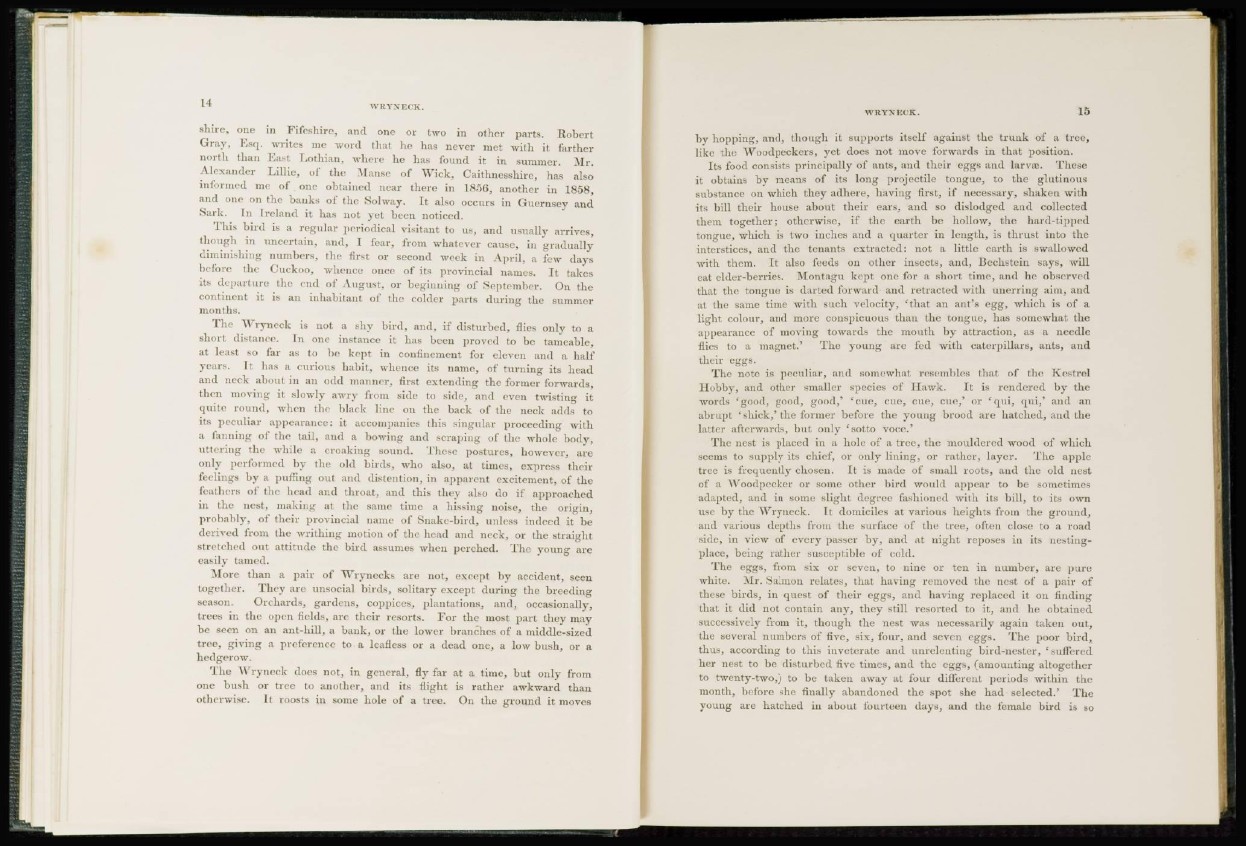
shire, one in Fifeshire, and one or two in other parts. Robert
Gray, Esq. writes me word that he has never met with it farther
north than Eas1 Lothian, where he has found it in summer. Mr.
Alexander LiHie, of the Manse of Wick, Caithnesshire, has also
informed me of one obtained near there in I80G, another in 1858,
and one on the banks of the Solway. It also occurs in Guernsey and
Sark. In Ireland it has not yet been noticed.
This bird is a regular periodical visitant to us, and usually arrives,
though in uncertain, and, I fear, from whatever cause, in gradually
diminishing numbers, the first or second week in April, a few days
before the Cuckoo, whence once of its provincial names. It takes
its departure the end of August, or beginning of September. On the
continent it is an inhabitant of the colder parts during the summer
months.
The Wryneck is not a shy bird, and, if disturbed, flics only to a
short distance. In one instance it has been proved to be tameable,
at least so far as to be kept in confinement for eleven and a half
years. It has a curious habit, whence its name, of turning its head
and neck about in an odd manner, first extending the former forwards,
then moving it slowly awry from side to side, and even twisting it
ipiite round, when the black line on the back of the neck adds to
its peculiar appearance: it accompanies this singular proceeding with
a fanning of the tail, and a bowing and scraping of the whole body,
uttering the while a croaking sound. These postures, however, are
only performed by the old birds, who also, at times, express their
feelings by a puffing out and distention, in apparent excitement, of the
feathers of the head and throat, and this they also do if approached
in the nest, making at the same time a hissing noise, the origin,
probably, of their provincial name of Snake-bird, unless indeed it be
derived from the writhing motion of the head and neck, or the straight
Stretched out attitude the bird assumes when perched. The young are
easily tamed.
More than a pair of Wrynecks are not, except by accident, seen
together. Thev are unsocial birds, solitary except during the breeding
season. Orchards, gardens, coppices, plantations, and, occasionally,
trees in the open fields, arc their resorts. For the most part they may
be seen on an ant-hill, a bank, or the lower branches of a middle-sized
tree, giving a preference to a leafless or a dead one, a low bush, or a
hedgerow.
The Wryneck does not, in general, fly far at a time, but only from
one bush or tree to another, and its flight is rather awkward than
otherwise. It roosts in some hole of a tree. On the ground it moves
WRYNECK. lo
by hopping, and, though it supports itself against the trunk of a tree,
like the Woodpeckers, yet does not move forwards in that position.
Its food consists principally of ants, and their eggs and larvae. These
it obtains by means of its long projectile tongue, to the glutinous
substance on which they adhere, having first, if necessary, shaken with
its bill their house about their ears, and so dislodged and collected
them together; otherwise, if the earth be hollow, the hard-tipped
tongue, which is two inches and a quarter in length, is thrust into the
interstices, and the tenants extracted: not a little earth is swallowed
with them. It also feeds on other insects, and, Bechstein says, wUl
cat elder-berries. Montagu kept one for a short time, and he observed
that the tongue is darted forward and retracted with unerring aim, and
at the same time with such velocity, 'that an ant's egg, which is of a
light colour, and more conspicuous than the tongue, has somewhat the
appearance of moving towards the mouth by attraction, as a needle
flics to a magnet.' The young are fed with caterpillars, ants, and
their eggs.
The note is peculiar, and somewhat resembles that of the Kestrel
Hobby, and other smaller species of Hawk. It is rendered by the
words 'good, good, good,' 'cue, cue, cue, cue,' or 'qui, qui,' and an
abrupt 'slack,' the former before the young brood are hatched, and the
latter afterwards, but only 'sotto voce.'
The nest is placed in a hole of a tree, the mouldered wood of which
seems to supply its chief, or only lining, or rather, layer. The apple
tree is frequently chosen. It is made of small roots, and the old nest
of a Woodpecker or some other bird would appear to be sometimes
adapted, and in some slight degree fashioned with its bill, to its own
use by the Wryneck. It domiciles at various heights from the ground,
and various depths from the surface of the tree, often close to a road
side, in view of every passer by, and at night reposes in its nestingplace,
being rather susceptible of cold.
The eggs, from six or seven, to nine or ten in number, are pure
white. Mr. Salmon relates, that having removed the nest of a pair of
these birds, in quest of their eggs, and having replaced it on finding
that it did not contain any, they still resorted to it, and he obtained
successively from it, though the nest was necessarily again taken out,
the several numbers of five, six, four, and seven eggs. The poor bird,
thus, according to this inveterate and unrelenting bird-nester, buffered
her nest to be disturbed five times, and the eggs, (amounting altogether
to twenty-two,) to be taken away at four different periods within the
month, before she finally abandoned the spot she had selected.' The
young are hatched in about fourteen days, and the female bird is so